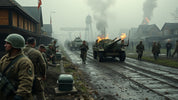
"Operation Market Garden: The Ambitious WWII Plan That Faltered"
, by Unboxify, 7 min reading time

, by Unboxify, 7 min reading time
On September 17th, 1944, thousands of Allied paratroopers descended from the skies into Nazi-occupied Netherlands in what was the largest airborne operation in history. Comprising British, American, and Polish troops, this endeavor aimed to open a route to the German Industrial Heartland, the Ruhr Valley, with hopes of ending World War II early. Instead, Operation Market Garden turned into one of the most significant Allied setbacks of the war. This blog post dives into the intricacies of the operation, analyzing why it ultimately became a tale of ambition and miscalculation.
Operation Market Garden was conceived by Field Marshal Bernard Montgomery, who gained acclaim commanding British forces in North Africa. Montgomery's plan was designed to favor a concentrated thrust into Germany, testing his preferred strategy for the final phase of the war in Europe. In contrast, Supreme Allied Commander Dwight Eisenhower advocated a broad strategy, distributing Allied forces over a wide front to maintain pressure on German positions. The liberation of Brussels in early September saw diminishing offensive momentum, prompting Eisenhower to approve a smaller-scale version of Montgomery's plan, delivering a test for the strategic viability of such a thrust and the effectiveness of the relatively new Allied Airborne Army.
Montgomery’s proposal was a massive flanking maneuver resembling the German strategies from both World Wars, combining two operations: Market and Garden.
This joint force, consisting of the 30th Corps under Lieutenant General Brian Horrocks, hoped to link up from the southwest to Arnhem, potentially ending the war by Christmas 1944.
The first day saw approximately 1,500 aircraft and over 400 gliders set off. Paratroopers landed with notable accuracy thanks to clear skies. However, this initial success paradoxically aided the Germans in pinpointing Allied drop zones and making quick deductions about Allied objectives. Major General Roy Urquhart's British Airborne Division was tasked with securing Arnhem's road and rail bridges but landed a dozen miles away due to anti-aircraft batteries, facing scattered opposition that delayed their progress. Additionally, due to insufficient planes, contingents of the division had to stay behind to secure landing sites and supply drops, and technical failures in radio sets eliminated General Urquhart's ability to coordinate efficiently.
Allied forces struggled with organizational setbacks. In Eindhoven, the 101st Airborne failed to secure crucial crossings, necessitating reconstruction and slowing the advance. Captured plans, glider crashes, and scattered landings betrayed carefully laid strategies. The single paved highway that the 30th Corps had to follow left them exposed to anti-tank fire, and bad weather delayed reinforcements for several days. Urquhart himself was pinned down and considered missing, while German reinforcements, alerted to Allied aims, bolstered defenses around key targets.
The parachute landings were successful, but the tight landings allowed the Germans to gauge Allied intentions quickly. Fierce resistance in Arnhem delayed objectives, and communication failures left sections isolated. The American 82nd Airborne Division captured key heights but faced resistance at river crossings, while the 101st captured three of five targets, only for bridges to be blown up, hampering their advance.
Bad weather delayed additional airborne waves. Despite an early lead, British troops in Arnhem faced strong German counterattacks. Communication issues persisted, fragmenting coordination. German forces, upon understanding Allied plans, focused on defending Nijmegen's Waal Bridge and fortifying positions against the advancing 30th Corps.
Second battalion defenses at Arnhem faltered under heavy German artillery. The 30th Corps reached Nijmegen but delayed further movements due to the city’s strategic importance. The failure to secure Arnhem’s bridges spelled trouble as reinforcements struggled against German defenses, and fresh paratrooper positions eroded slowly under relentless attack.
Although some progress was made through the crossing at Nijmegen, the counteroffensive pushed squads back to their landing zones. Desperate holds and valiant defenses ended in yielding, with German forces capturing remaining supplies. Continued bad weather and strong German defense coordination stymied Allied movements to support beleaguered divisions.
Allied capture of the Waal Bridge did little to salvage operations as heavy resistance compacted remaining troops, forcing withdrawals. Polish reinforcements arrived under fire and endured losses. Outmatched and outgunned, further attempts to link defensive positions gradually faltered in the face of unyielding defense and eroded morale.
Remaining troops at Arnhem Bridge succumbed to overwhelming forces, reinforcing the entrenched German hold. Outnumbered, exhausted, and undersupplied, evacuation became the only strategy amid deteriorating conditions. Efforts were now geared towards salvaging what remained of beleaguered forces under dark, treacherous circumstances.
Operational failings were multi-faceted. Overly optimistic timelines failed to account for armored opposition and delayed reinforcements and determined adversaries. Tactical miscalculations, such as the distance of drop zones from objectives, incomplete initial deployments, and dispersal of strategic force application, compounded with deteriorating weather conditions, resulted in a cascade of setbacks. Miscommunication, German strategic adaptations, and delayed advance due to misprioritized objectives further compounded operational ineffectiveness.
A misjudged drop zone distance, fragmented radio communication, and inadequate aircraft for quick deployment diluted element surprise. Forecasts missed predicting weather delays crucial for timely lifts and reinforcements leaving troops unsupported and undersupplied.
Allied plans becoming captured by Germans and the superb defensive coordination by adept strategist Field Marshal Walter Model reinforced foothold. Strengthened reinforcements, tactical adjustments, and paced defensive placements undercut allied advancements and led to reclaiming key positions and strategic locales.
Operation Market Garden remains a poignant reminder of the delicate balance between ambition and caution in military strategy and how the fog of war exacerbated by weather, communication failures, and timing constraints can turn a promising operation into a precarious venture unraveling the most elaborate plans.
The audacious, ambitious operation, though not devoid of valiant holds and strategic brilliance, serves as a lesson. Optimism must be tempered with cautious pragmatism, strategic applications synchronized with real-time adaptability, and logistical facets meticulously aligned for mission success in dynamically evolving battlegrounds.
Understanding the historical intricacies and analyzing operational missteps often forge the foundational tenets for future strategies propelling informed decision-making and a prudent evaluation when bellicose ambitions face the rugged pragmatism of battlefield realities.
Reflecting on Operation Market Garden underscores valuable lessons integrating operational capabilities with communication, logistics, and reaction adaptability to fortify military pursuits in complex, evolving theaters of conflict.
In retrospect, Operation Market Garden vividly underscores the complex dynamics and fortifies thinking integrating pragmatism with ambition, an essential consideration within the continually evolving strategic and tactical framework shaping contemporary and future military operations.
For a deeper dive into the later stages of World War II and its strategic perspectives, The Last 100 Days by John Toland and If You Survive by George Wilson provide significant insights. These narratives chronicle the European theatre's Downfall and encapsulate historical events enriching your understanding of this pivotal era. This engagement gives historical enthusiasts a lens into operational realities and victory's hard-fought nature.
We encourage readers to explore these resources, aiding your historical explorations and providing actionable outlooks for enriched understanding. Engaging with detailed narratives offers a profound contemplation of determined tenacity shaping victory amid tribulations and reinforcing the pertinent fact - war’s reminders of lessons unheeded serve as timeless touchstones guiding future ideals.







